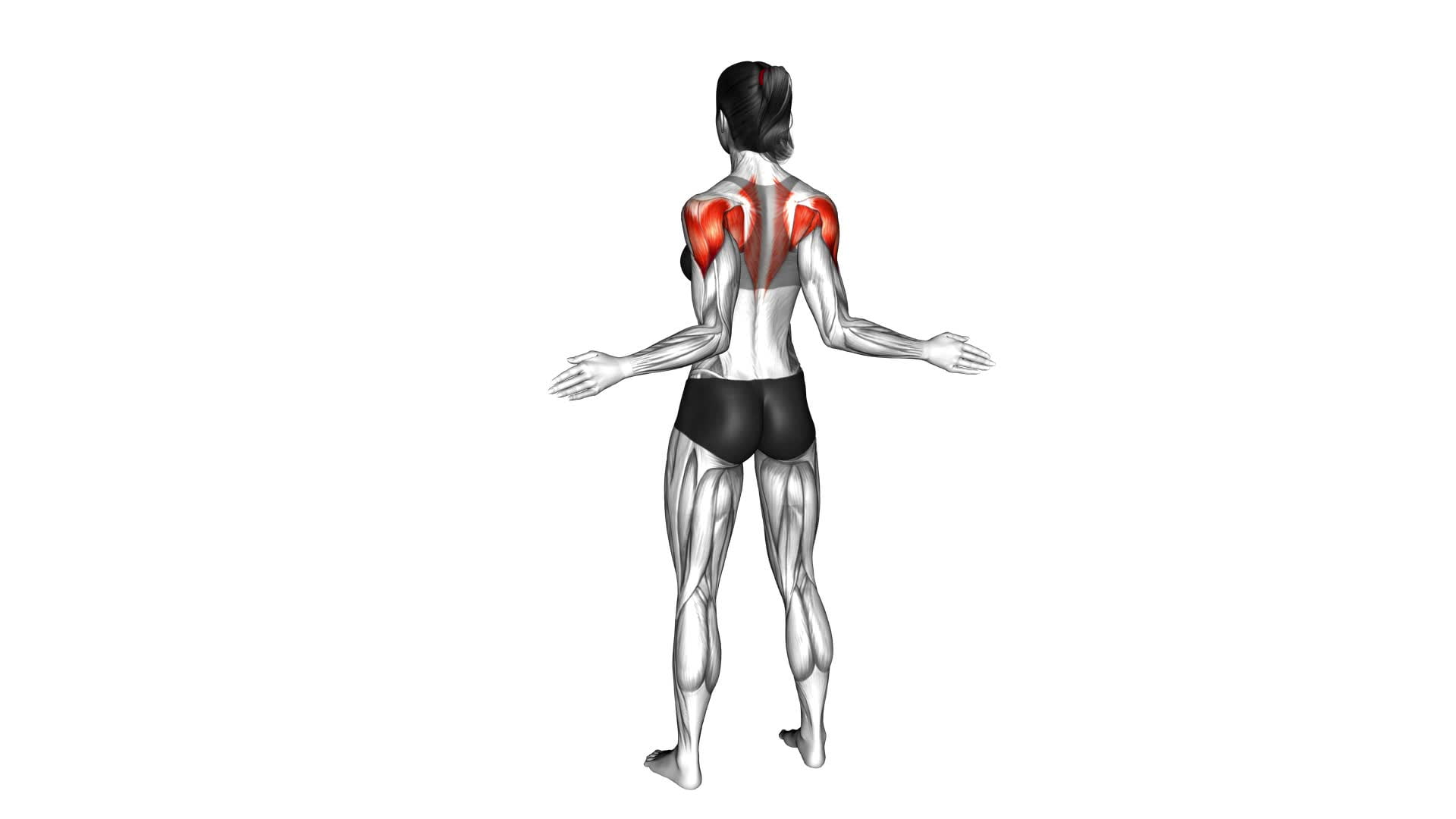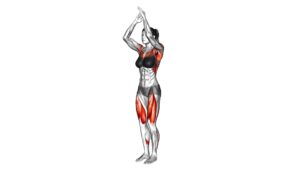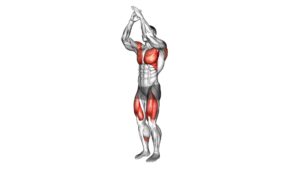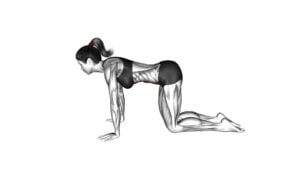Standing Side Circle Draw (female) – Video Exercise Guide & Tips

Are you looking for a challenging exercise to target your core and improve your balance? Look no further than the Standing Side Circle Draw.
Watch This Exercise Video
This video exercise guide provides step-by-step instructions and tips to help you master this move. With proper form and technique, you can reap the benefits of increased strength and stability.
Whether you're a beginner or an advanced fitness enthusiast, modifications and progressions are available to suit your needs.
Let's get started!
Key Takeaways
- The Standing Side Circle Draw targets core muscles and hip muscles, improving flexibility and range of motion in the hips.
- There are variations of the exercise for different fitness levels and goals, such as using resistance bands or an unstable surface.
- Proper form and technique involve maintaining a stable stance, engaging the core and back muscles, and avoiding swinging the arm or using momentum.
- Beginners should focus on correct form to maximize benefits and avoid common technique mistakes, such as incorrect stance and lack of core engagement.
Benefits of the Standing Side Circle Draw
You can maximize your workout by incorporating the Standing Side Circle Draw, which helps improve core strength and flexibility. This exercise has a range of benefits that make it a valuable addition to your fitness routine.
Firstly, the Standing Side Circle Draw targets your core muscles, including your abdominals, obliques, and lower back. By engaging these muscles, you can improve your stability and balance, which is crucial for various activities and sports.
Additionally, this exercise also works your hip muscles, including the glutes and hip flexors, which can help enhance your overall lower body strength and function.
Another benefit of the Standing Side Circle Draw is its ability to improve your flexibility. As you perform the exercise, you'll be required to move your leg in a circular motion, which can help increase the range of motion in your hips and improve your overall flexibility. This can be particularly beneficial for activities that require a wide range of leg movements, such as dancing or martial arts.
Moreover, the Standing Side Circle Draw offers variations that can cater to different fitness levels and goals. For example, you can increase the intensity of the exercise by using resistance bands or ankle weights to add resistance to your leg movements. Alternatively, you can modify the exercise by performing it on an unstable surface, such as a balance board or a foam pad, to challenge your stability muscles even more.
Proper Form and Technique for the Exercise
To perform the Standing Side Circle Draw with proper form and technique, there are a few important points to keep in mind.
As a beginner, focus on maintaining a stable stance with your feet shoulder-width apart and knees slightly bent.
Avoid the common mistake of using your arm strength instead of engaging your core and back muscles to initiate the movement.
Remember to maintain a smooth circular motion throughout the exercise, keeping your arm close to your body and your wrist straight.
Form Tips for Beginners
Make sure you maintain proper form and technique while performing the Standing Side Circle Draw exercise. For beginners, it's important to focus on the correct form to maximize the benefits of this exercise.
Start by standing with your feet shoulder-width apart and your knees slightly bent. Keep your core engaged and your back straight throughout the movement. As you draw the circle with your arm, make sure to keep your elbow locked and your wrist firm. Avoid swinging your arm or using momentum to complete the movement.
By maintaining proper form, you'll target the right muscles and prevent any unnecessary strain or injury.
Now, let's take a look at some common technique mistakes to avoid.
Common Technique Mistakes
What are some common mistakes to avoid when performing the Standing Side Circle Draw exercise?
Here are some tips for improvement:
- Incorrect stance: Avoid standing with your feet too close together or too far apart. Find a comfortable stance with your feet shoulder-width apart for better stability.
- Lack of core engagement: Remember to engage your core muscles throughout the exercise. This will help you maintain balance and control during the movement.
- Incomplete range of motion: Make sure to fully extend your arms and legs when performing the side circle draw. Avoid cutting the movement short as this can limit the effectiveness of the exercise.
Equipment Needed for the Workout
To properly perform the Standing Side Circle Draw exercise, you'll need some essential equipment. The good news is that you don't require any fancy or expensive gear for this workout. All you need is a sturdy exercise mat and a resistance band. The exercise mat will provide a comfortable and supportive surface for your feet, while the resistance band will add resistance to the exercise and help engage your muscles more effectively.
When choosing a resistance band, make sure it's the appropriate level of resistance for your fitness level. Beginners should start with a lighter resistance band and gradually increase the resistance as they become stronger. Safety precautions should also be taken when using the resistance band. Make sure it's securely anchored and that there's enough space around you to perform the exercise without any obstructions.
Now that you know the equipment needed for the Standing Side Circle Draw exercise, let's move on to discussing modifications and progressions for all fitness levels.
Modifications and Progressions for All Fitness Levels
To progress the Standing Side Circle Draw exercise and accommodate all fitness levels, you can increase the intensity by using a heavier resistance band or adding additional repetitions. Here are some modifications and progressions for all fitness levels:
- Modifications for beginners:
- Start with a lighter resistance band to build strength and gradually increase the resistance.
- Perform the exercise with smaller circles to reduce the range of motion and make it easier.
- If balance is an issue, hold onto a stable object like a chair or wall for support.
- Progressions for intermediate level:
- Increase the resistance by using a heavier resistance band or adding ankle weights.
- Perform the exercise on an unstable surface, such as a balance disc or BOSU ball, to challenge your core stability.
- Engage your core muscles and try to maintain a slight squat position throughout the exercise for an extra challenge.
- Advanced progressions:
- Use a resistance band with the highest level of resistance or switch to using dumbbells.
- Perform the exercise on a single leg to further challenge your balance and stability.
- Increase the speed of the circles while maintaining control and proper form.
Remember to listen to your body and progress at your own pace. It's important to choose modifications and progressions that challenge you, but still allow you to maintain proper form and avoid injury.
Common Mistakes to Avoid While Performing the Exercise
Avoid these common mistakes when performing the Standing Side Circle Draw exercise to ensure proper form and maximize its benefits.
One common mistake is failing to engage your core throughout the movement. It's important to keep your abdominal muscles tight and your spine aligned to prevent any strain on your lower back.
Another mistake is using excessive momentum to complete the circle. Instead, focus on controlled and deliberate movements to target the desired muscles effectively.
Additionally, avoid leaning or tilting your body to one side during the exercise, as this can lead to improper alignment and reduce the effectiveness of the exercise.
Lastly, be mindful of your arm positioning. Keep your arms extended and parallel to the floor, maintaining a slight bend in your elbows.
By avoiding these common mistakes, you can perform the Standing Side Circle Draw exercise with proper form and prevent any potential injuries.
Now, let's move on to some tips to enhance the effectiveness of the standing side circle draw.
Tips to Enhance the Effectiveness of the Standing Side Circle Draw
To enhance the effectiveness of the Standing Side Circle Draw, there are several key points to keep in mind.
First, focus on maintaining proper body alignment throughout the exercise, ensuring that your shoulders are stacked over your hips.
Second, engage your core muscles by pulling your belly button in towards your spine, which will help stabilize your body and increase the intensity of the workout.
Lastly, experiment with different hand grip adjustments to find the most comfortable and secure position for your individual needs.
Proper Body Alignment
Ensure that your body's alignment is proper to maximize the effectiveness of the Standing Side Circle Draw.
Proper body alignment is crucial for engaging your muscles effectively and preventing any potential injuries. Here are some tips to help you achieve optimal body alignment:
- Maintain core stability: Engage your core muscles by drawing your belly button towards your spine. This will help stabilize your torso and create a solid foundation for the exercise.
- Focus on balance techniques: Distribute your weight evenly between both feet and keep your knees slightly bent. This will enhance your balance and stability throughout the movement.
- Align your spine: Keep your back straight and avoid rounding or arching your spine. This will help maintain proper posture and prevent strain on your back.
Core Engagement Techniques
Engage your core muscles to enhance the effectiveness of the Standing Side Circle Draw.
Core activation is crucial for maintaining stability and control during this exercise. By engaging your core, you can target and strengthen the muscles in your abdomen, back, and pelvis, improving your overall balance and coordination.
To activate your core, focus on pulling your belly button towards your spine and contracting your abdominal muscles. This will create a stable foundation and allow you to perform the Standing Side Circle Draw with greater control and precision.
Additionally, engaging your core will help protect your lower back and prevent unnecessary strain or injury. Remember to maintain core engagement throughout the exercise for maximum muscle engagement and overall effectiveness.
Hand Grip Adjustments
By adjusting your hand grip, you can optimize the effectiveness of the Standing Side Circle Draw exercise. Here are some hand grip variations and hand placement techniques to enhance your workout:
- Experiment with different hand positions: Try gripping the handle with your fingers extended or wrapped around it. You can also try using an overhand grip or an underhand grip to target different muscles in your arms and shoulders.
- Adjust your hand width: Altering the distance between your hands on the handle can change the intensity of the exercise. Bring your hands closer together for a more challenging workout or widen your grip for a gentler variation.
- Use a neutral wrist position: Keep your wrists aligned with your forearms to maintain proper form and reduce the risk of injury.
Frequently Asked Questions
How Many Calories Can Be Burned by Performing the Standing Side Circle Draw?
By performing the standing side circle draw, you can burn a significant amount of calories while also improving your hip flexibility. This exercise targets multiple muscles in your body, including your core, arms, and legs. The continuous circular motion engages your muscles and raises your heart rate, resulting in calorie burn.
Additionally, the side-to-side movement helps to stretch and strengthen the muscles around your hips, enhancing your overall flexibility. Incorporating this exercise into your routine can contribute to your fitness goals.
Can the Standing Side Circle Draw Help Improve Flexibility in the Hips?
Performing the standing side circle draw can indeed help improve flexibility in your hips. By incorporating variations of this exercise into your routine, you can specifically target and strengthen the muscles surrounding your hip joints.
This increased flexibility can have numerous benefits, such as improved range of motion, reduced risk of injury, and better overall performance in activities that require hip mobility.
Incorporating the standing side circle draw into your fitness regimen is a great way to enhance your hip flexibility.
Is It Necessary to Warm up Before Doing the Standing Side Circle Draw?
To prevent injury and maximize the benefits of the standing side circle draw, it's essential to warm up before performing the exercise. Warming up increases blood circulation, loosens muscles, and prepares your body for physical activity.
Before starting the standing side circle draw, try dynamic stretches or light cardio exercises to get your heart rate up and warm up your muscles.
Can the Standing Side Circle Draw Be Modified for Individuals With Lower Back Pain?
Yes, the standing side circle draw can be modified for individuals with lower back pain.
To alleviate discomfort, you can try performing gentle exercises that target the core and lower back muscles. These exercises may include pelvic tilts, cat-cow stretches, and gentle twists.
It's important to listen to your body and modify the movements as needed.
Consulting with a healthcare professional or a qualified fitness instructor can provide you with personalized modifications and guidance.
How Often Should the Standing Side Circle Draw Be Incorporated Into a Fitness Routine for Best Results?
For best results, incorporate the Standing Side Circle Draw into your fitness routine regularly. The frequency of this exercise depends on your goals and current fitness level. To start, aim for 2-3 times per week. As you progress, you can increase the frequency to 4-5 times per week. Remember to listen to your body and adjust as needed.
Additionally, there are variations of the Standing Side Circle Draw that you can explore to add variety to your routine.
Conclusion
In conclusion, the standing side circle draw is a beneficial exercise that targets the muscles of the core and upper body. By maintaining proper form and technique, using the necessary equipment, and making modifications as needed, individuals of all fitness levels can benefit from this exercise.
It's important to avoid common mistakes and follow the provided tips to enhance the effectiveness of the workout. Incorporating the standing side circle draw into your fitness routine can help improve strength and stability.

Author
Years ago, the spark of my life’s passion ignited in my mind the moment I stepped into the local gym for the first time. The inaugural bead of perspiration, the initial endeavor, the very first surge of endorphins, and a sense of pride that washed over me post-workout marked the beginning of my deep-seated interest in strength sports, fitness, and sports nutrition. This very curiosity blossomed rapidly into a profound fascination, propelling me to earn a Master’s degree in Physical Education from the Academy of Physical Education in Krakow, followed by a Sports Manager diploma from the Jagiellonian University. My journey of growth led me to gain more specialized qualifications, such as being a certified personal trainer with a focus on sports dietetics, a lifeguard, and an instructor for wellness and corrective gymnastics. Theoretical knowledge paired seamlessly with practical experience, reinforcing my belief that the transformation of individuals under my guidance was also a reflection of my personal growth. This belief holds true even today. Each day, I strive to push the boundaries and explore new realms. These realms gently elevate me to greater heights. The unique combination of passion for my field and the continuous quest for growth fuels my drive to break new ground.







